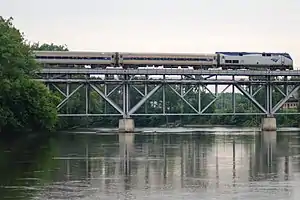Michigan Line
The Michigan Line, sometimes known as the Chicago–Detroit Line, is a railroad corridor that runs from Porter, Indiana, to Dearborn, Michigan. It carries Amtrak's Blue Water and Wolverine services, as well as the occasional local and/or unit train operated by Norfolk Southern.
| Michigan Line | ||||||||||||||||||||||||||||||||||||||||||||||||||||||||||||||||||||||||||||||||||||||||||||||||||||||||||||||||||||||||||||||||||||||||||||||||||||||||||||||||||||||||||||||||||||||||||||||||||||||||||||||||||||||||||||||||||||||
|---|---|---|---|---|---|---|---|---|---|---|---|---|---|---|---|---|---|---|---|---|---|---|---|---|---|---|---|---|---|---|---|---|---|---|---|---|---|---|---|---|---|---|---|---|---|---|---|---|---|---|---|---|---|---|---|---|---|---|---|---|---|---|---|---|---|---|---|---|---|---|---|---|---|---|---|---|---|---|---|---|---|---|---|---|---|---|---|---|---|---|---|---|---|---|---|---|---|---|---|---|---|---|---|---|---|---|---|---|---|---|---|---|---|---|---|---|---|---|---|---|---|---|---|---|---|---|---|---|---|---|---|---|---|---|---|---|---|---|---|---|---|---|---|---|---|---|---|---|---|---|---|---|---|---|---|---|---|---|---|---|---|---|---|---|---|---|---|---|---|---|---|---|---|---|---|---|---|---|---|---|---|---|---|---|---|---|---|---|---|---|---|---|---|---|---|---|---|---|---|---|---|---|---|---|---|---|---|---|---|---|---|---|---|---|---|---|---|---|---|---|---|---|---|---|---|---|---|---|---|---|
 The Wolverine crossing the St. Joseph River at Niles, Michigan | ||||||||||||||||||||||||||||||||||||||||||||||||||||||||||||||||||||||||||||||||||||||||||||||||||||||||||||||||||||||||||||||||||||||||||||||||||||||||||||||||||||||||||||||||||||||||||||||||||||||||||||||||||||||||||||||||||||||
| Overview | ||||||||||||||||||||||||||||||||||||||||||||||||||||||||||||||||||||||||||||||||||||||||||||||||||||||||||||||||||||||||||||||||||||||||||||||||||||||||||||||||||||||||||||||||||||||||||||||||||||||||||||||||||||||||||||||||||||||
| Status | Operating | |||||||||||||||||||||||||||||||||||||||||||||||||||||||||||||||||||||||||||||||||||||||||||||||||||||||||||||||||||||||||||||||||||||||||||||||||||||||||||||||||||||||||||||||||||||||||||||||||||||||||||||||||||||||||||||||||||||
| Owner | Amtrak, MDOT | |||||||||||||||||||||||||||||||||||||||||||||||||||||||||||||||||||||||||||||||||||||||||||||||||||||||||||||||||||||||||||||||||||||||||||||||||||||||||||||||||||||||||||||||||||||||||||||||||||||||||||||||||||||||||||||||||||||
| Locale | Indiana and Michigan | |||||||||||||||||||||||||||||||||||||||||||||||||||||||||||||||||||||||||||||||||||||||||||||||||||||||||||||||||||||||||||||||||||||||||||||||||||||||||||||||||||||||||||||||||||||||||||||||||||||||||||||||||||||||||||||||||||||
| Termini | Porter, Indiana Kalamazoo, Michigan | |||||||||||||||||||||||||||||||||||||||||||||||||||||||||||||||||||||||||||||||||||||||||||||||||||||||||||||||||||||||||||||||||||||||||||||||||||||||||||||||||||||||||||||||||||||||||||||||||||||||||||||||||||||||||||||||||||||
| Stations | 10 | |||||||||||||||||||||||||||||||||||||||||||||||||||||||||||||||||||||||||||||||||||||||||||||||||||||||||||||||||||||||||||||||||||||||||||||||||||||||||||||||||||||||||||||||||||||||||||||||||||||||||||||||||||||||||||||||||||||
| Service | ||||||||||||||||||||||||||||||||||||||||||||||||||||||||||||||||||||||||||||||||||||||||||||||||||||||||||||||||||||||||||||||||||||||||||||||||||||||||||||||||||||||||||||||||||||||||||||||||||||||||||||||||||||||||||||||||||||||
| Type | Inter-city rail | |||||||||||||||||||||||||||||||||||||||||||||||||||||||||||||||||||||||||||||||||||||||||||||||||||||||||||||||||||||||||||||||||||||||||||||||||||||||||||||||||||||||||||||||||||||||||||||||||||||||||||||||||||||||||||||||||||||
| System | Amtrak | |||||||||||||||||||||||||||||||||||||||||||||||||||||||||||||||||||||||||||||||||||||||||||||||||||||||||||||||||||||||||||||||||||||||||||||||||||||||||||||||||||||||||||||||||||||||||||||||||||||||||||||||||||||||||||||||||||||
| Services | ||||||||||||||||||||||||||||||||||||||||||||||||||||||||||||||||||||||||||||||||||||||||||||||||||||||||||||||||||||||||||||||||||||||||||||||||||||||||||||||||||||||||||||||||||||||||||||||||||||||||||||||||||||||||||||||||||||||
| Operator(s) | Amtrak | |||||||||||||||||||||||||||||||||||||||||||||||||||||||||||||||||||||||||||||||||||||||||||||||||||||||||||||||||||||||||||||||||||||||||||||||||||||||||||||||||||||||||||||||||||||||||||||||||||||||||||||||||||||||||||||||||||||
| Technical | ||||||||||||||||||||||||||||||||||||||||||||||||||||||||||||||||||||||||||||||||||||||||||||||||||||||||||||||||||||||||||||||||||||||||||||||||||||||||||||||||||||||||||||||||||||||||||||||||||||||||||||||||||||||||||||||||||||||
| Line length | 232 mi (373 km) | |||||||||||||||||||||||||||||||||||||||||||||||||||||||||||||||||||||||||||||||||||||||||||||||||||||||||||||||||||||||||||||||||||||||||||||||||||||||||||||||||||||||||||||||||||||||||||||||||||||||||||||||||||||||||||||||||||||
| Number of tracks | 1 | |||||||||||||||||||||||||||||||||||||||||||||||||||||||||||||||||||||||||||||||||||||||||||||||||||||||||||||||||||||||||||||||||||||||||||||||||||||||||||||||||||||||||||||||||||||||||||||||||||||||||||||||||||||||||||||||||||||
| Character | Single track with passing sidings | |||||||||||||||||||||||||||||||||||||||||||||||||||||||||||||||||||||||||||||||||||||||||||||||||||||||||||||||||||||||||||||||||||||||||||||||||||||||||||||||||||||||||||||||||||||||||||||||||||||||||||||||||||||||||||||||||||||
| Track gauge | 4 ft 8 1⁄2 in (1,435 mm) standard gauge | |||||||||||||||||||||||||||||||||||||||||||||||||||||||||||||||||||||||||||||||||||||||||||||||||||||||||||||||||||||||||||||||||||||||||||||||||||||||||||||||||||||||||||||||||||||||||||||||||||||||||||||||||||||||||||||||||||||
| Operating speed | Up to 110 mph (180 km/h) | |||||||||||||||||||||||||||||||||||||||||||||||||||||||||||||||||||||||||||||||||||||||||||||||||||||||||||||||||||||||||||||||||||||||||||||||||||||||||||||||||||||||||||||||||||||||||||||||||||||||||||||||||||||||||||||||||||||
| ||||||||||||||||||||||||||||||||||||||||||||||||||||||||||||||||||||||||||||||||||||||||||||||||||||||||||||||||||||||||||||||||||||||||||||||||||||||||||||||||||||||||||||||||||||||||||||||||||||||||||||||||||||||||||||||||||||||
It is owned by Amtrak for 98 miles (158 km) from Porter, Indiana, to Kalamazoo, Michigan, the longest stretch of Amtrak-owned rail outside of the Northeastern U.S. The 135 miles (217 km) of the line between Kalamazoo, Michigan, to Dearborn, Michigan was purchased by the State of Michigan in early 2013,[1] with the exception of a short stretch in Battle Creek, Michigan, which is owned by Canadian National Railway; the state-owned track is now dispatched and maintained by Amtrak as part of the Michigan Line.[2] The purchase agreement retains exclusive trackage right for freight by Norfolk Southern (NS), the previous owner of the line.[3]
The entire line was originally the mainline of the Michigan Central Railroad.
In 2002, the section from Porter to Kalamazoo became the first passenger rail line in the United States to have positive train control (PTC) technology installed,[4] specifically GE Transportation Systems' Incremental Train Control System (ITCS). In 2005, Amtrak received approval from the Federal Railroad Administration to run trains at up to 95 miles per hour (153 km/h).[5] Most Amtrak trains outside of the Northeast are limited to 79 mph (127 km/h) due to federal regulations. Regular service at 110 miles per hour (180 km/h) began from Porter to Kalamazoo on February 15, 2012.[6][7]
In November 2011, Michigan was awarded $150 million to expand its high-speed rail line to allow speeds of up to 110 mph (177 km/h) along the rest of the line from Kalamazoo to Dearborn, for a total 77% of the routes of Amtrak's Wolverine and Blue Water services between Detroit and Chicago.[8]
Despite the presence of the safety system on the Michigan Line, a derailment occurred just east of Niles, Michigan, on October 21, 2012, after a Wolverine train exited the main line and entered a freight yard due to a misaligned switch. The train had a green signal and was traveling at about 60 miles per hour (97 km/h) when it hit the switch. The incident was investigated by the National Transportation Safety Board and was found to be an Amtrak contractor's fault, caused by one of its employees improperly applying jumper wires to the signal system, bypassing safeguards that had been designed to prevent such an occurrence.[9]
References
- Bowen, Douglas (2012-05-08). "STB OKs Michigan DOT rail line buy". Railway Age. Archived from the original on 2019-05-15.
- "Amtrak Michigan Service Improvement Update" (PDF). Amtrak. 2013-02-04. Archived from the original (PDF) on 2017-09-15.
- Bowen, Douglas (2012-12-14). "Michigan DOT completes NS rail line buy". Railway Age. Archived from the original on 2019-05-15. Retrieved 2015-07-21.
- "Chicago-Detroit Service Levels". National Association of Rail Passengers. Archived from the original on 2011-07-16. Retrieved 2010-02-05.
- "AGE's Positive Train Control Technology is Full Speed Ahead on Amtrak's Michigan Line" (PDF). General Electric press release. 2005-10-11. Archived from the original (PDF) on 2007-10-25. Retrieved 2007-09-21.
- "All aboard! MDOT puts 110 mph special Amtrak train video on YouTube". Michigan Department of Transportation. 2012-02-15. Archived from the original on 2018-04-22. Retrieved 2012-11-06.
- Smigiel, Anthony (2012-02-15). "Amtrak celebrates increase in train speeds to 110 mph along Kalamazoo corridor from Chicago". Kalamazoo Gazette. Archived from the original on 2019-05-15. Retrieved 2019-05-15.
- Samuel, A. (2011-11-24). "$150m awarded to Michigan to expand high speed rail in the Midwest". Rail.co. Archived from the original on 2012-06-06. Retrieved 2011-11-23.
- Hilkevitch, Jon (2012-10-23). "NTSB: Chicago-Michigan Amtrak missed freight cars by 21 feet". Chicago Tribune. Archived from the original on 2019-05-15. Retrieved 2012-11-06.
External links
![]() Media related to Michigan Line at Wikimedia Commons
Media related to Michigan Line at Wikimedia Commons